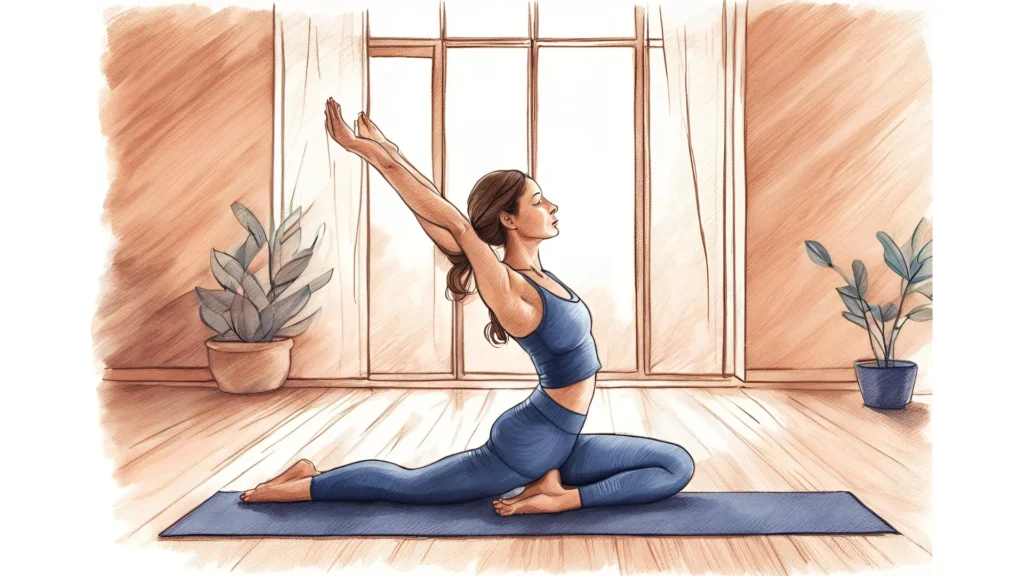Somatic workouts are a different kind of fitness routine that focuses on creating a strong connection between the mind and body. Unlike traditional exercises that often prioritize how we look on the outside or how well we perform, somatic workouts are all about being aware of what’s going on inside us and finding ways to release stress.
These workouts encourage us to listen to our bodies, understand our limits, and treat ourselves with kindness. And the best part? They can help us manage pain better, become stronger, and improve our flexibility.
At the core of every somatic workout is the idea of combining movement with mindfulness. This powerful duo has been proven to have a positive impact on both our physical and mental health. During these sessions, we might do things like focus on breathing deeply from our diaphragm, practice walking mindfully, or even explore movements that let us express ourselves freely.
“Somatic workouts are all about creating a strong mind-body connection through movement and mindfulness.”
Through somatic exercises, we can embark on a journey towards overall well-being. It’s not just about having a more flexible and resilient body; it’s also about finding clarity in our thoughts and achieving emotional balance.
“Somatic exercises are gaining popularity among those seeking relief from chronic pain and individuals who want a holistic approach to their well-being by acknowledging the link between their physical and mental states.”
What are Somatic Workouts?

Somatic workouts are a unique combination of physical exercise and mental mindfulness that focus on the strong link between body and mind. These practices prioritize two main aspects:
- Somatic Movement: These are gentle, conscious exercises that target tension release and mobility improvement. Instead of aiming for intense, calorie-burning activities, somatic movement emphasizes understanding the body’s cues and moving with purpose.
- Breathwork: Deep, diaphragmatic breathing is a fundamental part of somatic workouts. It helps calm the nervous system and creates a rhythm for the movements. This mindful breathing can lower stress levels and enhance overall respiratory function.
Practices like yoga and tai chi are often included in somatic workout routines because they naturally emphasize mindful movement and breathing. These disciplines support the somatic approach by:
- Promoting a balanced mind-body connection.
- Offering structured methods to increase body awareness.
- Providing techniques for stress management through controlled, intentional movements.
By incorporating these elements, somatic workouts provide not only physical advantages but also act as a way to find mental relaxation and emotional stability. As participants flow through poses or sequences in yoga or tai chi, they cultivate a deeper mind-body connection, which is crucial for the overall well-being that somatic workouts aim to attain.
Do Somatic Workouts Work?
Research shows that somatic workouts are effective for addressing various health issues, especially chronic pain management and mental health improvement. These exercises use the connection between the mind and body to promote overall well-being, making them an important part of holistic health practices.
1. Chronic Pain Management
People with long-term pain have found relief through somatic workouts. These gentle movements and focused awareness help them identify areas of tension. By consciously releasing this tension, many experience a reduction in discomfort. Studies suggest that this approach can reset the nervous system, teaching the body to move away from pain patterns.
2. Mental Health Benefits
Our mental well-being is greatly influenced by our physical state. Somatic workouts encourage us to be present and mindful, which are associated with lower levels of stress and anxiety. As we pay attention to our bodies during these exercises, we often feel better emotionally and mentally, and experience fewer symptoms of depression.
3. Emotional Release
Somatic exercises provide an opportunity to express and process emotions that may be stored in the body. This practice helps us become more aware of our bodies, allowing us to identify and let go of emotional blockages. As a result, many people find themselves more resilient to emotional stress and better able to cope with life’s challenges.
By making somatic workouts a regular part of our lives, we can expect significant improvements in both our physical and mental health. These benefits are backed by a growing body of scientific research.
How to start Somatic Workouts?
Embarking on a journey with somatic exercises requires an understanding of their gentle nature and how these movements can enhance your fitness routine. Below are practical suggestions to help you get started and maintain consistency:
1. Begin with Intention
Set clear intentions for integrating somatic exercises into your daily life. Whether it’s reducing stress, improving flexibility, or simply dedicating time to self-care, having a goal will anchor your practice.
2. Designate a Specific Time and Space
Choose a quiet spot and a consistent time each day for your somatic practice. This helps in establishing a routine, making it easier to stick to your commitment.
3. Incorporate Variety
Mix different types of somatic exercises into your routine. Include activities like diaphragmatic breathing, mindful walking, or cathartic movement to keep the practice engaging.
4. Step-by-Step Guide: Try These Simple Somatic Exercises at Home
- Diaphragmatic Breathing: Lie down comfortably on your back. Place one hand on your chest and the other on your abdomen. Breathe deeply through your nose, directing the air downward so that your abdomen rises more than your chest.
- Pelvic Tilts: Still lying on your back with knees bent and feet flat on the floor, gently arch your lower back, then flatten it against the floor. Move slowly and mindfully to the rhythm of your breath.
- Shoulder Rolls: Stand or sit with a straight spine. Roll your shoulders forward gently, then up towards the ears, back, and down in a circular motion. Repeat in the opposite direction.
- Mindful Walking: Walk at a slower pace than usual, paying close attention to the sensation of each foot as it makes contact with the ground.
- Cathartic Movement: Put on music that resonates with you and allow your body to move freely without judgment or specific structure.
5. Listen to Your Body
Pay attention to how you feel before, during, and after the exercises. Adjust movements according to comfort and physical sensations.
By incorporating these tips and exercises into your fitness regimen, you create a foundation for enhancing body awareness and nurturing the mind-body connection essential for somatic workouts.
Do Somatic Workouts work for Weight Loss?
The journey to weight loss often involves rigorous physical exercise. Many people believe that high-intensity workouts are the key to shedding those extra pounds. However, somatic exercises have recently gained attention as a potential aid in achieving weight loss goals.
Somatic workouts are different from traditional exercises in that they focus on the mind-body connection rather than just burning calories. The main principles of somatic exercises include:
- Inner awareness: Paying attention to your body’s sensations and limits during movement.
- Stress relief: Using gentle movements to release tension and promote relaxation.
- Overall well-being: Prioritizing holistic health by considering both physical and mental aspects.
How Do Somatic Workouts Help with Weight Loss?
While somatic workouts may not have the same calorie-burning effects as intense cardio sessions, they can still play a valuable role in a balanced weight loss strategy. Here’s how:
- Improved body awareness: Engaging in activities like deep breathing or mindful yoga flows can help you become more in tune with your hunger and fullness cues. This heightened awareness may contribute to better portion control and healthier eating habits, indirectly supporting weight loss.
- Reduced emotional eating: Somatic exercises often incorporate relaxation techniques that can help manage stress levels. By addressing the underlying triggers of emotional eating, these workouts may assist in breaking unhealthy food patterns.
- Enhanced mobility: Some somatic practices focus on gentle stretching and mobility exercises, which can improve flexibility and joint function. This increased range of motion may facilitate other forms of physical activity, allowing you to engage in more calorie-burning workouts.
Creating an Effective Somatic Workout Plan
Interested in creating a somatic workout plan of your own? It’s not as difficult as it may seem.
1. Consider Your Needs
Start by thinking about your current fitness level and any health conditions you may have. It’s important to tailor your somatic workouts to suit your individual requirements. You should aim to challenge yourself without overexerting, as the objective is to care for your body rather than strain it.
2. Embrace Variety
Balance is crucial when designing a somatic workout plan. Include a mix of exercises that target different parts of your body and mind. Make sure you address all aspects of your well-being, such as:
- Strength
- Flexibility
- Stress relief
- Emotional release
3. Be Consistent
Consistency is key in reaping the benefits of somatic workouts. Just like with any other form of exercise, regular practice is essential. Aim to incorporate these exercises into your routine on a frequent basis.
To get you started, here’s a simple somatic workout routine suitable for beginners:
- Warm-Up: Begin with deep diaphragmatic breathing exercises to center yourself.
- Gentle Movement: Slowly transition into mindful walking or gentle yoga poses.
- Targeted Exercise: Choose a specific somatic exercise that fits your needs for the day – it could be anything from stretching exercises for relieving muscle tension to cathartic movements for emotional release.
- Cool Down: Wind down with guided meditation or progressive muscle relaxation techniques.
Remember, this plan should serve as a flexible guide rather than a rigid schedule. Feel free to make adjustments based on your comfort level and preferences – after all, the essence of somatic workouts lies in connecting with your body and honoring its unique needs.
Popular Somatic Workout Programs You Can Try
In the landscape of fitness and wellness, a myriad of somatic workout programs are available, each offering a distinct blend of movement and healing. Here are some globally recognized options that you can explore, including those available in Singapore:
1. The Class by Taryn Toomey: This cathartic workout disrupts traditional fitness routines by merging physical effort with emotional release. It presents a transformative experience through sound, breath, and movement designed to enhance self-understanding.
2. Jaycee Gossett’s Dancing Freedom: Gossett is a renowned figure in the world of somatic workouts. Her program offers liberation through dance, encouraging participants to embrace their natural rhythm and experience joy.
3. Sarah Warren’s Somatic Yoga: Warren’s yoga style aims at fostering mindfulness and aligning body movements with the breath. The emphasis is on gentle poses promoting tranquility and inner peace.
4. Hanna Somatic Education: Created by Dr. Thomas Hanna, this method entails slow controlled movements meant to reset muscle length and improve overall body function.
For those based in Singapore:
1. BodyTree Academy: Based in Singapore, BodyTree Academy offers a variety of somatic movement classes that focus on improving mobility, flexibility, and strength whilst reducing tension and stress.
2. Move to Live: Another local option is Move to Live which provides classes in Hanna Somatics aimed at reducing pain and enhancing body awareness.
3. Somatic Therapy Asia: Somatic Therapy Asia in Singapore provides individualized somatic therapies, using methods like Feldenkrais and Thomas Hanna, to promote healing and balance in the body-mind connection.
4. Chuan Studio: Chuan Studio promotes overall well-being through a holistic approach to somatic practices, combining elements of dance, yoga, and somatic education in diverse classes that enhance body awareness and self-expression.
While each program has its unique approach to somatic workouts, the common objective remains the same; to assist individuals in strengthening their mind-body connection while promoting physical wellness. Explore these programs to find one that aligns with your personal wellness goals.
The Mind-Body Connection: Key to Unlocking the Benefits of Somatic Workouts

The concept of mind-body connection, a central tenet of somatic therapy, takes center stage in the realm of wellness and fitness. This connection holds the key to unlocking the transformative power of somatic workouts.
Somatic workouts, with their focus on internal physical sensations, perceptions, and experiences, empower you to reconnect with your body through conscious movement. By prioritizing inner awareness, these exercises provide a unique approach to improving strength and flexibility while relieving stress and tension.
As you dive deeper into this practice, you’ll soon discover that somatic workouts are not just about physical activity. They are alternative wellness practices that go beyond traditional fitness methods.
What sets them apart?
- They recognize that our bodies play an active role in our overall well-being, rather than just being passive vessels for our minds.
- In addition to managing chronic pain and stress, they also support emotional release and increase body awareness.
- They promote mindfulness in how we move, encouraging us to pay attention to our movements and their impact on us.
Start your journey to wellness with somatic workouts. Immerse yourself in mindful movements that shape both your body and mind. Notice the difference as you become more attuned to what your body needs and how it responds. Discover the pleasure of embracing fitness as a holistic practice that cares for your physical and mental health.
Read More: How to begin Exercising with Chronic Pain: 5 Simple Steps


